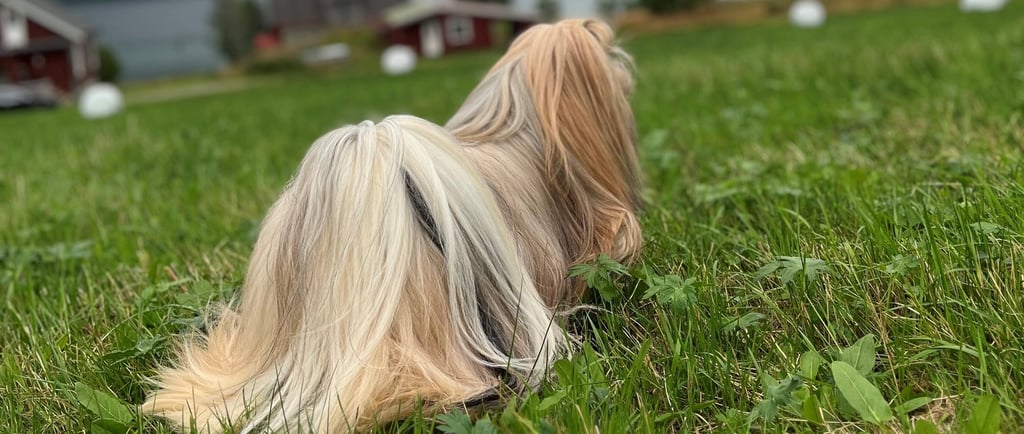🐾 From Monastery to Runway: The Fabulous (and Slightly Tragic) Tale of the Lhasa Apso
Once upon a time, in the snow-dusted heights of the Himalayas, there lived a dog so revered, so mysterious, and so gloriously hairy that Buddhist monks believed it brought good fortune. This was the Lhasa Apso—a dog bred not for Instagram likes, but for guarding monasteries, surviving sub-zero nights, and judging your karma from a cushion. Fast forward a century, and this noble mountain mutt has been transformed into a show-ring superstar with a neck arch that rivals a ballerina’s and a gait that screams “I don’t do mud.” Let’s unravel the silky strands of history and see how the Lhasa Apso went from rugged temple guardian to runway-ready fluffball.
Laura Lhasafam
6/5/20253 min read


🏔️ The OG Apso: A Dog of the Mountains (and the Monks)
The earliest known breed standard for the Lhasa Apso dates back to 1901, courtesy of Mr. Lionel Jacobs, a British government official stationed in Punjab and a founding member of the Northern India Kennel Club. In his delightfully Victorian prose, Jacobs described the Lhasa (then called the “Lhasa Terrier”) as a breed of great variety:
Some were as large as Russian Poodles (yes, really),
Others as tiny as Maltese,
And their personalities ranged from terrier-like to “large dog of Tibet” energy.
These dogs weren’t just pets—they were sacred. For centuries, they were bred in Tibetan monasteries and rarely seen outside Lhasa. In fact, it was said that only Buddhist priests could own them, and exporting one was akin to smuggling a national treasure. But where there’s demand, there’s a trader with a yak caravan, and soon these dogs found their way to India, Kashmir, and eventually, the West.
🇬🇧 The British Invasion: From Temple to Tea Room
From 1907 to 1934, Jacobs’ standard reigned supreme in both India and England. The first English champion, Ch. Rupso, was imported from Shigatse in 1907 and crowned in 1908. But in 1934, the British Kennel Club decided it was time for a glow-up. They revised the standard, smoothing out the rustic edges and adding a touch of British refinement.
The Americans, never ones to miss a trend, adopted the British standard almost verbatim in 1935. For a while, the world was united under one Apso banner.
But then came the 1960s. And with them, change.
🇨🇦 Canada Enters the Chat: Elegance Over Endurance
The Canadian and British standards began to diverge from the original Tibetan type. Suddenly, the Apso needed:
An arched neck (because nothing says “mountain dog” like swan posture),
A high-set tail (for maximum drama),
And a trot as the “normal pace” (despite the fact that real Apsos prefer galloping, climbing, and occasionally levitating).
The Canadian standard even introduced the phrase “impression of elegance.” Which is lovely—if you’re describing a ballerina. Less so if you’re talking about a dog that once guarded Himalayan monasteries from snow leopards.
🧬 The Shih Tzu-ification of the Apso
As the breed standard evolved, so did the dog. The modern British (FCI) and Canadian standards began to favor traits more commonly associated with the Shih Tzu:
Oval eyes instead of round,
Barrel chests instead of long rib cages,
And shorter bodies that scream “showdog” more than “snowdog.”
Even the bite changed. The original standard called for a “level mouth”—meaning jaws of equal length, regardless of tooth alignment. But somewhere along the way, “mouth” became “bite,” and suddenly the Apso was expected to have a pincer occlusion. One word, 180-degree shift. Oops.
🇺🇸 America Holds the Line (Mostly)
To their credit, the Americans have stayed truest to the original 1901 and 1935 standards. The U.S. Lhasa Apso is still a bit more rugged, a bit less ornamental. But even here, the shift from “mouth” to “bite” has caused confusion—and a few dental dilemmas.
🧘♂️ From Survivor to Showstopper: What Have We Done?
So what does all this tell us?
The Lhasa Apso, once a hardy little sentinel of the Himalayas, has been slowly transformed into a glamorous, high-maintenance showdog. The traits that helped it survive at 16,000 feet—like a long rib cage, slightly bowed legs, and a sturdy build—have been replaced by features that win ribbons but wouldn’t last a week in Tibet.
Why? Because the show ring rewards flash over function. And the breed standards have followed suit.
🐶 Final Thoughts: Let the Apso Be Apso
To all the breeders, judges, and dog lovers out there: maybe it’s time to take a step back. To remember that the Lhasa Apso isn’t just a pretty face—it’s a piece of living history. A dog that once thrived in the harshest conditions on Earth, not because it looked elegant, but because it was tough, smart, and full of character.
Let’s celebrate that. Let’s protect that. And maybe—just maybe—let the Apso be Apso again.
